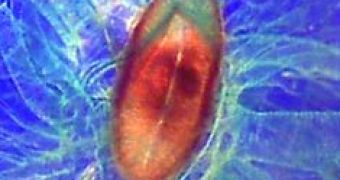Silk and purple (a pigment obtained from a marine snail) were two of the most costly products of the antiquity, as purple silk was the mark of royalty.
Now a Japanese team has genetically engineered silkworms to directly synthesize purple silk.
This research would change the silk color at the genetic level. "The experiment is the first to successfully color a natural fiber using molecular genetic engineering to transfer a natural pigment", said author Takashi Sakudoh of the University of Tokyo.
Naturally, silkworms can produce cocoons in many hues of white, yellow, golden yellow, straw, salmon, pink and green. These colors are induced by two pigment types, carotenoids and flavonoids, which are ingested from the mulberry leaves by the silkworm. White appears when the silkworms carry on a mutation of Y ("yellow blood") gene that impedes them to extract yellow carotenoids.
The Sakudoh's team discovered that mutated insects produced a non-functional form of the carotenoid-binding protein (CBP), aimed to aid pigment uptake. Through genetic engineering, the research team introduced an unmutated Y gene into the white silk producing insects, achieving yellow-colored cocoons. Cross-breeding resulted in even more vivid yellow variants.
The same technique could be useful in achieving flesh and reddish colored silk, which "may lead to the ability to produce silks of various colors with a similar transgenic strategy," the authors write.
The silkworms (Bombyx mori) have been cultivated in northern China for more than 5,000 years now, and the Chinese are envied for their silk knowledge; in Europe, silk technology was introduced only very late, in the XIIIth century, brought by the famous Italian traveler Marco Polo.
About 2,100 silkworm cocoons are needed to make a Japanese kimono.

 14 DAY TRIAL //
14 DAY TRIAL //